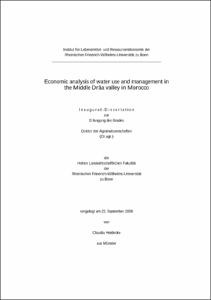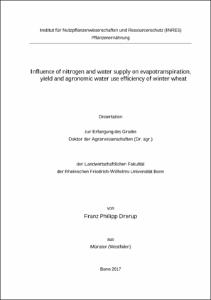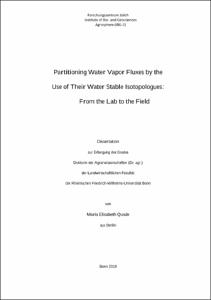Heidecke, Claudia: Economic analysis of water use and management in the Middle Drâa valley in Morocco. - Bonn, 2010. - Dissertation, Rheinische Friedrich-Wilhelms-Universität Bonn.
Online-Ausgabe in bonndoc: https://nbn-resolving.org/urn:nbn:de:hbz:5N-20220
Online-Ausgabe in bonndoc: https://nbn-resolving.org/urn:nbn:de:hbz:5N-20220
@phdthesis{handle:20.500.11811/4192,
urn: https://nbn-resolving.org/urn:nbn:de:hbz:5N-20220,
author = {{Claudia Heidecke}},
title = {Economic analysis of water use and management in the Middle Drâa valley in Morocco},
school = {Rheinische Friedrich-Wilhelms-Universität Bonn},
year = 2010,
month = feb,
note = {In arid and semi arid regions of the world irrigation is crucial for agricultural production as it stabilizes the water supply for crops and, hence, prevents extreme fluctuations in production and prices. In the Drâa river basin in southern Morocco agricultural production is highly dependent on irrigation as precipitation rates are not sufficient for crop water requirements. The objective of the thesis is to analyze the economic impact of water use on agriculture for the Middle Drâa river basin. The thesis develops an integrated approach for water management of the six Drâa oases and contributes to the discussion of the impact of climate change and water shortage on the income situation of the farmers in arid regions. At first an introduction to the economics of water management and a methodological background for this study is given. This is followed in Chapter 2 by an analysis of water resources and water management in the Drâa valley. Ground- and surface water use and their interactions constitute a complex system of conjunctive water use between the six oases. Chapter 3 analyses agricultural production which is an important activity in the region. Survey data is used to understand farmer’s production structure and strategies under water scarcity which confirmed that water is the major production constraint.
The thesis proceeds along four papers in which a model is developed and applied for policy analysis. The model maximizes farm income over all oases under water resource constraints. In order to realistically represent the situation, the conjunctive use of surface and groundwater and their interactions are endogenously modeled. In the first paper in Chapter 4 the model is applied in a recursive-dynamic evaluation to assess the impact of groundwater charges on agricultural water use. The paper concludes that groundwater pricing stabilizes water availability and groundwater tables over years. The second paper in Chapter 5 builds upon Chapter 4 and compares surface and groundwater pricing and a combination of the two options. The relationships between water use and income are analyzed in detail. The chapter concludes that groundwater pricing is a favorable option as the stabilization function of groundwater can thus be internalized. In the third paper in Chapter 6 the model is further extended to incorporate water quality being an important constraint to crop yield formation. Sensitivity analysis is conducted to distinguish the effects of water deficit and salt rates in irrigation water. The fourth paper in Chapter 7 addresses the impact of climate change on the income situation considering water quantity and water quality. Water inflow distributions are estimated based on historical data and climate change scenarios and are introduced into the model as a random variable to capture the stochastic nature of surface water availability. Monte Carlo technique is applied to obtain water use, farm income and the stabilization value of groundwater for current and for future climatic conditions. In the end of the thesis the major findings are summarized and recommendations for future research of water management are given.},
url = {https://hdl.handle.net/20.500.11811/4192}
}
urn: https://nbn-resolving.org/urn:nbn:de:hbz:5N-20220,
author = {{Claudia Heidecke}},
title = {Economic analysis of water use and management in the Middle Drâa valley in Morocco},
school = {Rheinische Friedrich-Wilhelms-Universität Bonn},
year = 2010,
month = feb,
note = {In arid and semi arid regions of the world irrigation is crucial for agricultural production as it stabilizes the water supply for crops and, hence, prevents extreme fluctuations in production and prices. In the Drâa river basin in southern Morocco agricultural production is highly dependent on irrigation as precipitation rates are not sufficient for crop water requirements. The objective of the thesis is to analyze the economic impact of water use on agriculture for the Middle Drâa river basin. The thesis develops an integrated approach for water management of the six Drâa oases and contributes to the discussion of the impact of climate change and water shortage on the income situation of the farmers in arid regions. At first an introduction to the economics of water management and a methodological background for this study is given. This is followed in Chapter 2 by an analysis of water resources and water management in the Drâa valley. Ground- and surface water use and their interactions constitute a complex system of conjunctive water use between the six oases. Chapter 3 analyses agricultural production which is an important activity in the region. Survey data is used to understand farmer’s production structure and strategies under water scarcity which confirmed that water is the major production constraint.
The thesis proceeds along four papers in which a model is developed and applied for policy analysis. The model maximizes farm income over all oases under water resource constraints. In order to realistically represent the situation, the conjunctive use of surface and groundwater and their interactions are endogenously modeled. In the first paper in Chapter 4 the model is applied in a recursive-dynamic evaluation to assess the impact of groundwater charges on agricultural water use. The paper concludes that groundwater pricing stabilizes water availability and groundwater tables over years. The second paper in Chapter 5 builds upon Chapter 4 and compares surface and groundwater pricing and a combination of the two options. The relationships between water use and income are analyzed in detail. The chapter concludes that groundwater pricing is a favorable option as the stabilization function of groundwater can thus be internalized. In the third paper in Chapter 6 the model is further extended to incorporate water quality being an important constraint to crop yield formation. Sensitivity analysis is conducted to distinguish the effects of water deficit and salt rates in irrigation water. The fourth paper in Chapter 7 addresses the impact of climate change on the income situation considering water quantity and water quality. Water inflow distributions are estimated based on historical data and climate change scenarios and are introduced into the model as a random variable to capture the stochastic nature of surface water availability. Monte Carlo technique is applied to obtain water use, farm income and the stabilization value of groundwater for current and for future climatic conditions. In the end of the thesis the major findings are summarized and recommendations for future research of water management are given.},
url = {https://hdl.handle.net/20.500.11811/4192}
}









